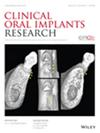Dental Research in the Digital Age: The Registry-Based Clinical Trial.
IF 5.3
1区 医学
Q1 DENTISTRY, ORAL SURGERY & MEDICINE
引用次数: 0
Abstract
With the global increase in the volume of digital health data recorded and accessible through national and institutional databases, such as clinical registries and evidence-based registries, new strategic approaches are now feasible in medical research. These approaches include the registry-based clinical trial (RBCT) design, where large-scale datasets-which grow exponentially over time (referred to as big data)-can be used to identify eligible study participants from a medical registry containing trial-specific inclusion criteria. The RBCT approach may also be used to establish historical control groups for prospective interventional studies that enable rapid recruitment with a lower study budget, while providing high statistical power. Hence, obstacles frequently encountered when conducting randomized controlled trials, such as difficulties in recruiting a sufficient sample size in a reasonable time period, may be overcome for specific research questions. This innovative study design of an RBCT aims to combine the external validity of medical registries with the internal validity of the traditional study designs, and has the potential to influence clinical decision making and healthcare policy. The aim of this perspective article is to describe this new methodological approach and to critically analyze the future possibilities and challenges of RBCTs in dental and implant research.数字时代的牙科研究:基于注册的临床试验。
随着通过国家和机构数据库(如临床登记和循证登记)记录和获取的数字卫生数据量在全球范围内的增加,在医学研究方面,新的战略方法现在是可行的。这些方法包括基于注册的临床试验(RBCT)设计,其中大规模数据集-随时间呈指数增长(称为大数据)-可用于从包含试验特定纳入标准的医疗注册中识别合格的研究参与者。RBCT方法也可用于建立前瞻性介入研究的历史对照组,以较低的研究预算快速招募,同时提供高统计能力。因此,在进行随机对照试验时经常遇到的障碍,如在合理的时间内招募足够的样本量的困难,可以克服具体的研究问题。这项创新的RBCT研究设计旨在将医疗登记的外部效度与传统研究设计的内部效度结合起来,并有可能影响临床决策和医疗保健政策。这篇前瞻性文章的目的是描述这种新的方法方法,并批判性地分析rbct在牙科和种植体研究中的未来可能性和挑战。
本文章由计算机程序翻译,如有差异,请以英文原文为准。
求助全文
约1分钟内获得全文
求助全文
来源期刊

Clinical Oral Implants Research
医学-工程:生物医学
CiteScore
7.70
自引率
11.60%
发文量
149
审稿时长
3 months
期刊介绍:
Clinical Oral Implants Research conveys scientific progress in the field of implant dentistry and its related areas to clinicians, teachers and researchers concerned with the application of this information for the benefit of patients in need of oral implants. The journal addresses itself to clinicians, general practitioners, periodontists, oral and maxillofacial surgeons and prosthodontists, as well as to teachers, academicians and scholars involved in the education of professionals and in the scientific promotion of the field of implant dentistry.
 求助内容:
求助内容: 应助结果提醒方式:
应助结果提醒方式:


